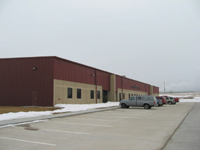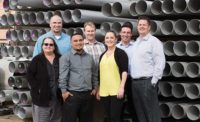
Steve Anderson can't recall the last time a "pure" PVF wholesaler ascended to the ASA presidency. Various predecessors have come from predominantly PVF firms -- notably Michigan's John Bertsch -- but also handled significant amounts of plumbing-heating supplies. Anderson's Central States Industrial Supply (Omaha, Neb.) distributes nothing but industrial pumps and PVF. Anderson has his finger firmly on the pulse of that membership segment.
"Our company is recognized as a regional leader in the PVF and industrial pump marketplace," says Anderson. "Our focus is to provide our customers single-source access to multiple capabilities involving fluid handling equipment and accessories. The motto on the front of our headquarters building, 'People committed to adding value,' pretty well sums up our business proposition."
Anderson also feels the PVF sector's pain. Central States sells to industrial markets that have been hammered by the nation's ongoing manufacturing slump, although it doesn't have its eggs entirely in one basket. The company's industrial pump division operates a niche business that is always in demand by OEM and MRO accounts, and the Midwest's food processing and ethanol industries have compensated somewhat for the slowdown in hard goods manufacturing. After finishing a very profitable 2001 (its best year ever), Central States earlier this year consolidated from four branches to two. Three Iowa locations were combined into Cedar Rapids, a move that will result in better control over expenses and customer service levels.
"Our biggest challenge is maintaining profitability in an increasingly competitive environment," Anderson comments. "We are addressing this 'opportunity' in multiple ways, including the hiring and retention of high quality employees, more application of technology to cut errors and rework, maintenance of our ISO 9002 quality system, careful budget control and higher sales productivity." Central States is one of the few distributors in the industry that is ISO 9002 registered, and has been for six years.
"Because of our broad range of products and services, including engineered products, our competition covers a wide range of business models, from the nationals, to regional and local distributors, to niche distribution and rep firms. We try to stay abreast of what these competitors are up to, and to stay a step or two ahead of them," says Anderson.
Anderson notes that his membership in the Affiliated Distributors buying group has been a big advantage in helping the firm compete against large distributors, and participation in SupplyForce.com has enabled Central States to go after national contracts in its trading area, which stretches through most of the nation's agricultural heartland.

Driving Out Costs
Central States has embarked on a Six Sigma program to continue to drive costs out of the business while improving service levels to the customer. "Waste and rework consume a hefty share of our resources," said Anderson. "We want to be able to employ those resources to build business instead. We are implementing plans now to grow our service and repair revenues, and to utilize our excellent shop capabilities to attract fabrication business, particularly in the food and pharmaceutical industries."In short, we are intent on growing the value-added side of our business, whether that be MRO contracts for PVF products or providing third party in-plant service and repair for our end users."
In the following interview, Anderson repeatedly draws attention to the importance of technology to ASA members, and his company practices what he preaches.
Central States uses the NxTrend enterprise software for its main operating system. In addition, it has integrated a "Brio" data warehouse and reporting system, enabling managers to access discrete information at will. It also is networked across the company on Microsoft Exchange, using Outlook, Work, Excel and other productivity pieces that allow its people to exchange information readily.
The company recently implemented "Terminal Server," which provides remote access, via the Internet, to an individual's desktop at work. It is now piloting "Saleslogix" CRM software and plans on implementing it throughout the inside and outside sales forces in 2003.
"With each of these technological tools, we attempt to improve both productivity and effectiveness. Access to data is critical to process improvement," says Anderson.

Our interview with Steve Anderson begins.
Supply House Times:What are the top items on your agenda as President of ASA?Anderson: We'll continue to serve our members in the three areas they need a national association most: technology, education and government affairs -- working together with our vendors to pursue solutions. A good example is the convention program this year -- everyone in one room working together, talking, raising questions, exploring answers and laying our cards on the table.
Our Education Foundation is already doing a great job, thanks to the endowment, although it's been a tough year on us, since only the fund's earnings can be used for spending.
The government affairs program will continue to look for proactive ways to help our members, such as working with the Department of Labor to help members recruit and train new employees, like Home Depot is doing. We also continue to support NAW and are able to leverage their activities to our best benefit.
Then there is the technology front, where much of what we do is appreciated by too few of our members. It's one of those cases where we're providing solutions to problems some of our members haven't recognized they have, or haven't had time to address. However, we believe that continuing to work on an industry database and catalog, and promoting the use of e-commerce, is the best thing we can do to ensure the future viability of our channel.
Also, one of my top priorities will be membership growth. Membership is the fuel that runs the association, and it's going to be a key focus while I'm president. While we have traditionally focused on marketing joint membership with our regional affiliates, there are cases where companies are seeking specific benefits. Our new structure will allow us to tailor a membership plan that's appropriate to them, whether it involves dual membership or membership confined to the national organization. There are a lot of companies out there that have not considered membership for a variety of reasons. I'm planning to go after them.
Supply House Times: What are the biggest challenges facing the PHCP industry and how is ASA helping wholesalers address them?
Anderson: Profit margin squeeze is affecting all of our members and prospective members. They are looking for new ways to reduce expenses. Technology can provide the tools to do so.
Workforce issues are also at the forefront. We need to find new ways to recruit new employees, retain them and train them to do a better job. Survival of the channel depends on it.
Supply House Times: What are some of ASA's noteworthy new initiatives?
Anderson: Certainly the product database, when it's complete, will draw a substantial amount of interest because of its value as a profitability tool, both internally at the distributor level, and between distributors and their vendors. Also, educational programs such as the new "Essentials of Profitable PHCP Distribution" book the Foundation is producing.
We're also very excited about the new convention format unveiled in Toronto, since it's a risky enterprise to bring everyone together in one room and hope that the sparks that fly end up being productive, not destructive.
The ISH-NA show, of course, is another new opportunity, where our members will be able to see new products from around the world.
ASA is no longer responsible for the day-to-day management of the show, which has allowed us to pare down our staff size. Nevertheless, we still are active partners in the show, and continue to pursue other shows to consolidate with ISH. We haven't given up on trade show consolidation by a long shot, and still believe it's in the best interests of the industry.
Supply House Times: How are relations between ASA and the regional affiliates and what can be done to improve them?
Anderson: I think they're probably better now than they have been in the past 20 years. We're all in this together, and through the White Paper, we've developed some guidelines that both the national and regional groups have been following to make sure that we each work together to provide the best combination of services for our members. We're working more like a team now than ever before.
Supply House Times: There has always been grumbling in the background from PVF distributors about lack of representation in ASA. As one of them, how do you feel about that?
Anderson: We always have felt outnumbered. I think that came into play originally because of the old arrangement that you couldn't belong to ASA without belonging to a regional, and a lot of industrial wholesalers had no interest in joining a regional because they found it pretty much full of plumbing wholesalers. Networking could be great because I've learned at least as much from the plumbing folks I know as from PVF contacts, but there were hardly any of our vendors at those meetings, and as a result a lot of industrial members thought they shouldn't have to belong to a regional. The regional issue was addressed with ASA's reorganization. We'll work hard to attract members to both, but we're not going to disenfranchise someone because a wholesaler doesn't want to belong on a regional basis.
But other than that, I think with the IPD (Industrial Piping Division), of which I'm a member, most PVF members feel pretty comfortable with ASA.
Supply House Times: Has consideration ever been given to establishing regional chapters of the IPD?
Anderson: There are relatively few pure industrial PVF distributors compared with plumbing, so I don't really think regionals are needed for us. Plus, we tend to service larger territories per branch than plumbing distributors and all of us tend to compete with one another in a given region, which also argues against regional IPD chapters.
Supply House Times: What is ASA doing to strengthen its position in the face of competition for time and dollars from buying groups and other organizations that target narrower interests?
Anderson: That's a good question, because that is precisely our biggest challenge. We have to continue to provide meaningful benefits they can't get anywhere else, which is yet another case for our three-legged stool of education, government affairs and technology. We are still the best forum to address broader industry issues.
We'll be getting into some strategic planning in the near future to help us be sure we're remaining relevant and providing value. We're not going to stick our heads in the sand and ignore the changing needs of our constituents.
What are the most important benefits a wholesaler enjoys from membership in ASA?
Anderson: What one gets out of ASA is directly proportionate to what one puts into it. By that I mean that those who don't participate in our conventions, for example, are missing one of the most important benefits of membership - new information, making new acquaintances, sharing tips and experiences.
Everyone benefits from our work in promoting industry standards and our lobbying efforts in Washington. And everyone in the long run will benefit from a strengthened industry as a result of our agenda. But those who get and stay involved with our group will be those who benefit the most. Personally, involvement in the regional association and ASA national has resulted in vastly increased benefits for my company and me than before.
Supply House Times: How has the industry changed since you have been in it?
Anderson: Consolidation, the commoditization of product brand names, proliferation of import competition, integrated supply and national contracts, deterioration of supplier/distributor relationships, the margin squeeze - I could go on and on. It's definitely not the same industry we started with in 1971, but it's still people dealing with people, solving problems, and that's why it remains a very rewarding career.
Supply House Times: What do you see as the biggest problems facing the industry?
Anderson: The biggest is apathy - the technology issue, for instance. We feel a mandate from members to help in compiling an industry database. This is a massive job, yet a lot of distributors out there don't see a need for one, or it's not a high priority with them. So I think our biggest problems are sometimes things we don't recognize as problems. Instead, we focus on other things, like what our major competitors are doing, or other short-term problems.
Technology can help us with the margin squeeze everyone is facing. We tend to do business all year the way we've always done it, yet at the end of the year the bottom line isn't there like it used to be. We've always been focused on revenue generation in our industry and are way behind in cost reduction compared with other industries.
But I see technology as a valuable tool in solving problems facing us all. It's a matter of finding the time and materials to educate our people. <<
Sidebar
Central States Industrial Supply Profile
Facilities: Headquartered in Omaha, Neb.; branch in Cedar Rapids, Iowa. Combined warehouse space of about 45,000 sq. ft., including a full service pump service and repair and fabrication shop in Cedar Rapids.
Employees: 70
Key Management: Steve Anderson, president; Dick Stenger, partner, vice president/chief financial officer; Joann Luhrs, controller; Corry Walton, sales and marketing manager/pump division; David Leger, sales and marketing manager/PVF group; Mike Brimeyer, hub operations manager/Omaha; Dave Sunstrom, hub operations manager/Cedar Rapids; and Al Pfeifer, MIS manager.
Markets: PVF and industrial pump; marketed to industrial end users, OEMs and mechanical/industrial contractors.
Customer Base: Food and chemical process, manufacturing, contracting companies and corn processors.
Capsule History: Founded by Dick Stenger in November 1971 in Omaha, Neb. Anderson joined the company as a partner in July 1972. Opened a branch in Des Moines in 1975 and in 1987 added a location in Davenport, Iowa. From the beginning, focused on distribution of industrial specialty products such as industrial thermoplastics, quarter turn valves and automation, sanitary food processing piping systems and other products that, at the time, were not considered commodity products. In the early 1980s moved into full line PVF commodity products to allow for more growth. Added an industrial pump division (EPD) as a separate profit center in 1985 and acquired an industrial pump distribution company (headquartered in Cedar Rapids, Iowa) in 1998 into which the EPD division was merged.
Up Close & Personal
Steve Anderson was born in Chattanooga and raised in Memphis, Tenn. He spent four years in the U.S. Air Force, then attended Memphis State University, graduating with a bachelor's degree in marketing. Wife Gretchen and he have two children, Benjamin - currently a junior in chemical engineering at Carnegie Mellon University in Pittsburgh - and Kate, a freshman at the University of Kansas in journalism and mass communications. Other children, Leigh Ann, Stephen, Sam and Kris, live in Memphis, Richmond, and Dallas. Steve's hobbies include reading, fishing and boating.
His career has included job stints as a medical lab and dental lab technician, electrical design draftsman and retail sales. After graduating from college, he worked for the Metal Goods division of Alcan Aluminum, a distributor of stainless and non-ferrous metal products nationwide. He was transferred to Omaha and after a year and a half, met Dick Stenger, joining Stenger's company as a partner in 1972.


